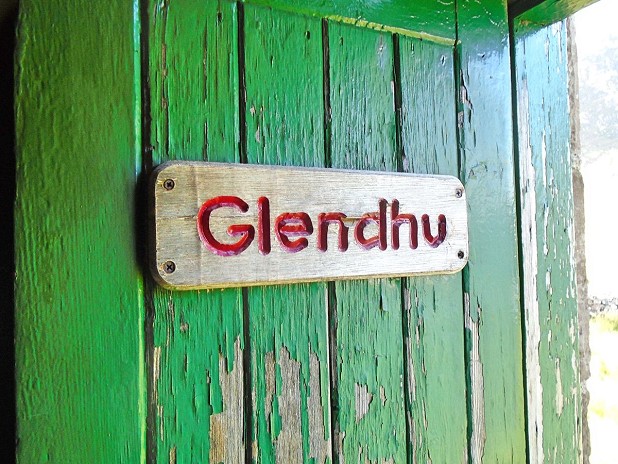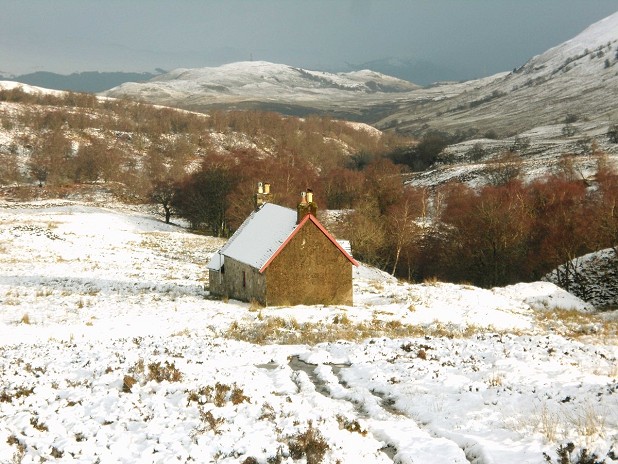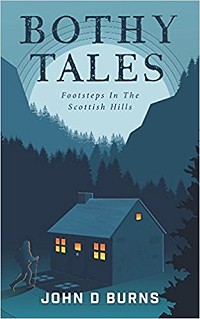Are Bothies Being Commercialised to Death?
From guided walks to guidebooks, there are dark rumblings in bothy-going circles that bringing money and publicity into the scene risks undermining the free-for-all ethos that makes bothies so special. Where will it all end, asks John Burns.
A few weeks ago I made a post in a Facebook group about mountain bothies. In the post I suggested that, in 30 years time, folk will only be able to visit bothies in organised groups. This was after noticing that a mountain festival was offering a guided walk to a bothy for a fee. This appeared to me to be contrary to the bothy code which expressly forbids the use of bothies for commercial purposes.
I made the post for two reasons. Firstly, because I do believe that our relationship with the outdoors is likely to change radically over the next 30 years and secondly, like a mischievous small boy poking a sleeping elephant with a pointed stick, I wanted to see what would happen.
Just like the small boy with the stick I wasn't quite prepared for the eruption of fury that ensued. It seems that my post helped bring to the fore an argument amongst devotees of the bothy world that has been rumbling along for many years. That the post got over 300 responses ranging from reasoned argument to character assassination, testifies to the passions that these humble shelters can arouse. I see this as a positive thing, it means that, at least to a significant proportion of hill goers, bothies are important places.
The MBA walk an unenviable tight rope between maintaining the goodwill of landowners and providing basic shelters that allow us to enjoy wonderful nights in the hills. It is the MBA's policy, or perceived policy, towards commercialisation that evokes the greatest vitriol. It's difficult to unravel the various points of view. If you put three bothies dwellers round a bothy fire you'll have at least four opinions.
The work of the MBA, and the people who volunteer for it, has given us all a priceless gift of wonderful shelters in wild places. Let us not allow our passion for these places to tear apart the very thing we value most.
Keep them under the radar?
There are those who are against any kind of publicity for bothies. Some folk argue that to promote the existence of these remote and open shelters is to risk unleashing a tide of visitors that will so enrage landowners as to result in many being withdrawn from public use, threatening the very existence of mountain bothies as we know them.
In past years many bothies were known only to a small community of devotees who whispered their locations to other members of the brotherhood in dark glens on long bothy nights. But those days are gone forever. The MBA now publishes brief descriptions of bothies on its website, with basic details on locations given as grid references. This nominally restricts access to those who at least have some basic map reading ability. Given the MBA's charitable status it has an obligation to act for the public good and probably had no choice but to make available information on where the bothies it maintains are.
Other bothies, maintained by estates rather than the MBA, remain 'off grid', and some in the bothy community still struggle to preserve knowledge of their whereabouts to a select few against the ever-increasing flow of the information superhighway. I once, in my innocence, wrote a blog about such a secret shelter. Such was the diatribe of abuse I received that for months I could only venture out after dark heavily disguised as a singing nun.
The secrecy horse may have well and truly bolted, but advocates for restricting information point to the problems that overuse can bring, from overcrowding to litter and, in some cases, vandalism. Such behaviour has indeed resulted in the closure of some bothies, for example Poca Bhudie. Other bothies were destroyed by fire and were not permitted to be restored, like Nest of Fannich. Bothies are an important part of our outdoor heritage and it seems wrong that that rights of access hang on the slender thread of landowner's goodwill. To stray into that argument is, however, to sail into the deep, shark infested waters of land reform and beyond the scope of this short article.
Or sing their praises?
The other side of the bothy argument is occupied by those who wish to promote the existence of bothies, on the basis that full disclosure beats secrecy. Some advocates have even produced bothy guides which encourage bothy novices to tear themselves way from virtual reality and enjoy a night of bliss in a cold, damp howff, without benefit of electricity, running water or even a decent broadband connection.
At the heart of their argument is the contention that, far from bothies suffering from a deluge of folk newly acquainted with their existence, the greatest threat to their existence is a slow decline in use as the numbers of bothy dwellers suffers a long-term decline. My own anecdotal experience wandering the wild glens of the Highlands suggests that whilst some of the better known bothies are experiencing greatly increased footfall, the majority are actually seeing a decline.
A Cairngorm ranger told me, as he tactfully suggested that it might not be a good idea for a man of my advanced years to wander into a blizzard alone, that in the 1960s there had been fifty folk one New Year in and around the Shelter Stone howff. These days this isolated refuge might have to wait until February for its first visitor. How many walkers would visit Moal Budhie bothy if the Cape Wrath Trail didn't run past its door?
A recent survey by the Ramblers suggested that, for people under 35, lack of knowledge of where they could safely go, what routes there are and where they can stay in the outdoors was a major barrier to accessing the outdoors (see UKH news). This is surprising in an age where information pours at us from every available scheme.
Old codger alert:
When I began walking and climbing, if you wanted to know about a bothy or a hill you asked around until you found someone who had been there. They told you from personal experience the best way to get there and what places to avoid. Can it be that this method of getting information was more effective than the internet? Perhaps we are all deluged by so much information it simply becomes white noise.
Part of my Facebook post related to how our relationship with the outdoors is changing. There are so many more barriers for people under the age of 35 accessing the outdoors than there were for my generation of baby boomers. The nature of employment has changed so the security I and my friends enjoyed no longer exists, and many younger people are in lower paid employment which means they are forced to work longer hours. These and other barriers mean that that the next generation of hillwalkers is likely to be much smaller than our present and may herald the beginning of a significant decline.
The point I was making in my post is that future hillwalkers may well lack the confidence to wander the hills unsupported and will perhaps increasingly seek the support of guided parties. The technology now exists to track every hillwalker in the British Isles. Like many, I enjoy my time in the hills as it enables me to step away from the tyranny of the mobile phone into a world where I can wander free from the regulations that stifle us in everyday life. That too is a luxury that may soon be coming to an end. Since every hillwalker could carry a device that will enable them to be located instantly in an emergency how long will it be before such technology becomes mandatory for the hillwalker? I hate the idea of such an intrusion, but if it were to overcome the necessity for prolonged searches, in hazardous conditions, by MRT personnel, do not such esoteric arguments become redundant?
I cannot predict with any accuracy how our relationship with the outdoors will change but I can predict, with absolute accuracy, that it will change. There are many issues that beset our lives in the outdoors. There is the whole re-wilding debate, the effects of driven grouse shooting, the proliferation of fresh bulldozed tracks across our hills and the growth of windfarms and hydro schemes. All these issues are overshadowed by the overarching debate over land reform.
Cut to the case in point. The MBA do not accept that guided walks, which they do not directly organise, nor any of the guidebooks that have been published, represent the commercialisation of bothies. The book that has generated most controversy is Geoff Allan's Bothy Bible. Mr Allan makes a donation to the MBA from what he receives from sales. The MBA argues that they were made aware of the book close to the publication date and felt that as the book showed their work in a very positive light there was no reason to decline the author's offer of a donation. They see the book as good, free publicity for their work and feel that it would have been a very odd decision for any charity to decline such support.
Some accuse the MBA of profiting indirectly from the work of its volunteers.
Neil Reid, a Trustee of the MBA and a Maintenance Officer for a bothy refutes this:
"The only thing that we have to be careful of is that we do not accept money from an illegal source, or one lacking integrity or which could harm the reputation of the charity" he says.
"None of those applied in this case. It passed the test. In fact it is a fine book and has given many people lots of pleasure and portrays the Association very well. We could also reasonably argue that it would be quite wrong of us not to accept such a donation as it furthers the cause of the charity."
Whether the debate will ever be resolved to everyone's satisfaction, it does highlight one thing - how passionately many people feel bothies and the contact they give us with wild places. The work of the MBA, and the people who volunteer for it, has given us all a priceless gift of wonderful shelters in wild places. Let us not allow our passion for these places to tear apart the very thing we value most. Perhaps there should be more protests, maybe we should all be making our voices heard in defence of our hills and our right to roam in them. There are so many issues and many more voices but there is an increasing need for the outdoor community to make its voice heard.
Now, picture in your mind an elephant sleeping peacefully and a small boy, stick in hand, tip-toeing up to it.
About John Burns' new book Bothy Tales







